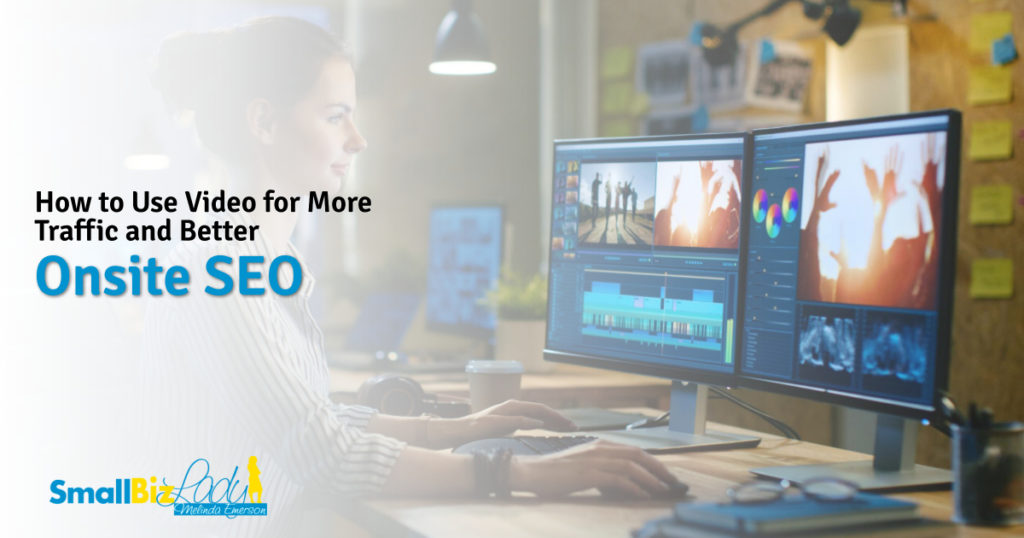How to Use Video for More Traffic and Better Onsite SEO

 Search engine optimization (SEO) is a popular term in marketing and business-building circles. It makes sense. If you can drive consistent organic traffic to your company’s website, you’ll have a much easier time generating quality leads for your business.
Search engine optimization (SEO) is a popular term in marketing and business-building circles. It makes sense. If you can drive consistent organic traffic to your company’s website, you’ll have a much easier time generating quality leads for your business.
In this article, we’ll take a look at what onsite SEO is (as opposed to off-site SEO) and how video can help you rank higher in search engine results.
What is Onsite SEO?
Onsite SEO, AKA on-page SEO, is the act of optimizing your website to make it more visible in search engine results. It’s the opposite of off-site SEO, which refers to any action taken outside of your website with the goal of improving its rank in search engines.
Without proper onsite SEO best practices in place, it will be nearly impossible for your website to appear in Google, Bing, and the other search engine’s results. Since 93% of internet experiences start with a search engine, getting onsite SEO right is a big deal.
Fortunately, video can improve your onsite SEO efforts. In fact, your website is 53x more likely to reach the front page of Google if it includes a video. Why? Because people love them!
How to Use Video to Boost Onsite SEO

As we’ve seen, onsite SEO is vital to the success of most businesses. Unfortunately, SEO isn’t an exact science and getting it right can be tricky — unless you follow the tips, tricks, and best practices outlined below, of course!
Use the following four ideas to boost your onsite SEO efforts with video:
1. Know Your Audience
Like all good marketing efforts, proper onsite SEO starts with a deep understanding of your target market. If you don’t know what your unique audience is looking for online, you won’t be able to create video content that attracts and engages them.
Is your audience looking to be educated or entertained? Do they want to watch explainer videos, product demos, or video case studies?
Get to know your audience before you start creating videos for your company. That way you can come up with a strategy that will attract your target market, have a great chance to rank in search engine results, and actually convert traffic into leads and customers.
2. Lock Down the Technical Details
Video can help your onsite SEO efforts, but only if you lock down the technical details of any webpage that your video is published to. Keep these things in mind:
- Use your target keyword in your page title. Then use both target and related keywords throughout the body text of the webpage.
- Make your video the right length. While there’s no “magic length” to ensure your video shows up in search results, we suggest looking at the videos currently ranked and aiming for a similar minute count.
- Encourage likes, comments, and shares. A search engine’s job is to show its users the most relevant results for their queries. By increasing the amount of engagement your videos generate, you prove to search engines that your content is what viewers want.
3. Give Your Videos Some Context
Video alone won’t help your onsite SEO efforts. You also need to surround your videos with related text to give them context. Just make sure this related copy includes the keywords you’re trying to rank for! That way search engines understand what the web page is about.

Having trouble coming up with something relevant to write? Sometimes simply transcribing your video is all that’s required.
4. Know Where to Publish Videos
Finally, where you publish your video is very important. Should you publish them to YouTube or directly to your webpage? The place you choose will depend on your goals.
Because Google owns YouTube, videos hosted on this platform generally rank better. YouTube also makes it incredibly easy to host videos, has an enormous user base that you can promote your content to, and allows for video monetization.
But, you might consider self-hosting if you want to complete control over every aspect of the viewer experience and want access to more detailed analytics than YouTube offers.
In Summary
Video can improve your onsite SEO efforts and help your website rank higher in search engine results. But you have to follow the four best practices listed above. If you do, you should begin to see your content climb the rankings, leading to more traffic and leads for your company!
 Author the Author: Jacob Plumb is head of SEO marketing at Biteable and knows a thing or two about helping videos rank. Try Biteable for yourself here.
Author the Author: Jacob Plumb is head of SEO marketing at Biteable and knows a thing or two about helping videos rank. Try Biteable for yourself here.
Read More
Source

No comments